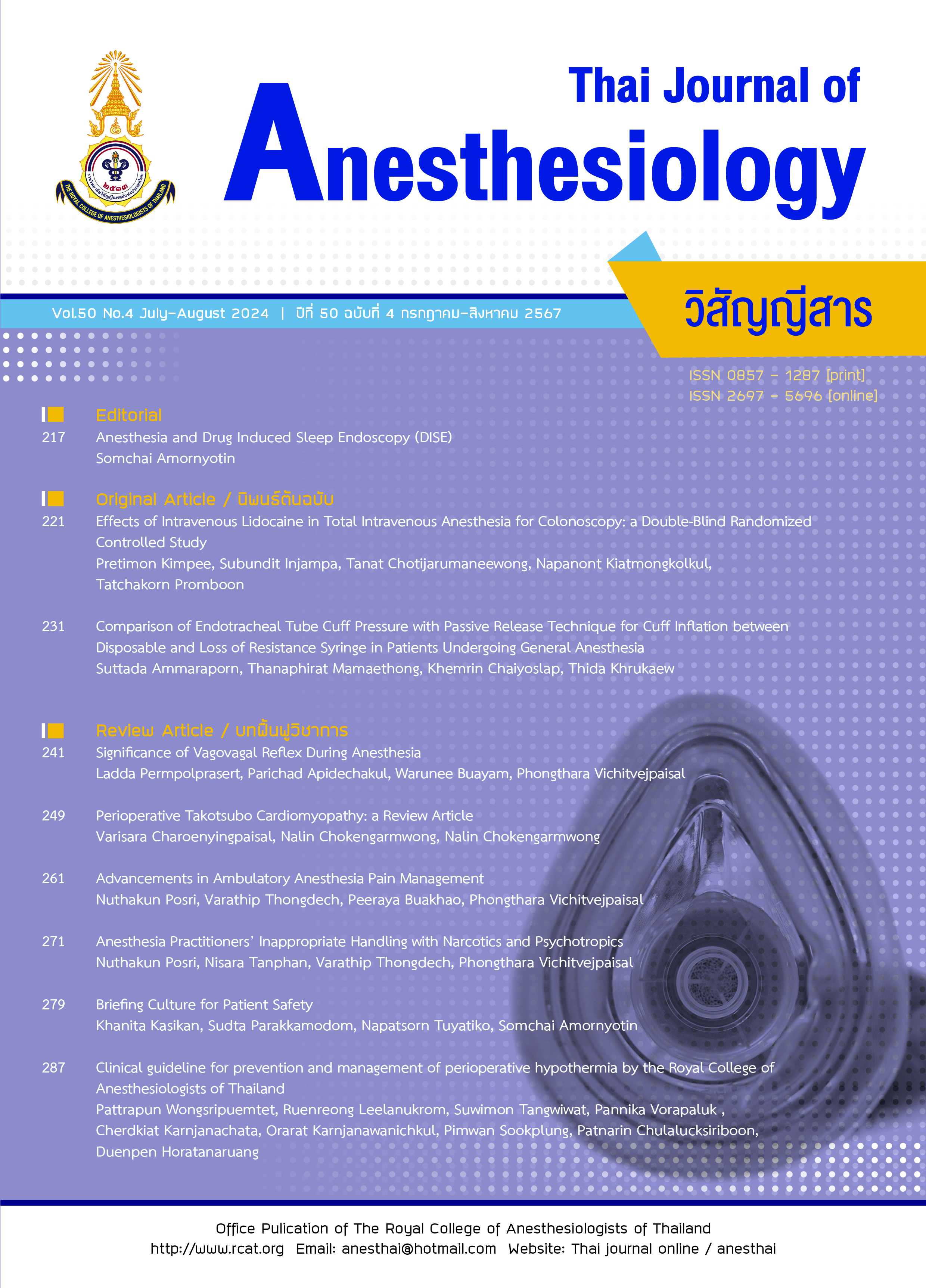Anesthesia and Drug Induced Sleep Endoscopy (DISE)
Main Article Content
Abstract
Drug-induced sleep endoscopy (DISE) is a diagnostic procedure used to evaluate the upper airway in patients with obstructive sleep apnea (OSA) by mimicking natural sleep conditions. OSA is a disorder characterized by repetitive collapse of the upper airway during sleep. Standard treatment for OSA is continuous positive airway pressure therapy (CPAP). However, up to 50% of patients with OSA are unable to tolerate CPAP obligating alternative treatments. DISE allows for the direct visualization of airway dynamics, which aids in identifying the site and pattern of obstruction, thereby guiding treatment decisions. It has been the most used technique to identify specifc areas of obstruction and patterns of airway collapse that serves as a baseline screening tool for both surgical and non-surgical options.1 A variety of drugs are available for sedating patients undergoing DISE, with the goal of achieving a level of sedation that closely mimics natural sleep. The most often utilized agents are propofol, midazolam, and dexmedetomidine.2 While no absolute contraindications exist unique to DISE, relative contraindications include drug allergy to selected sedative agents, pregnancy, and medical comorbidities resulting in signifcant airway compromise. Anesthesia plays a crucial role in DISE, as it must induce a sleep-like state without compromising airway patency or patient safety.
Article Details

This work is licensed under a Creative Commons Attribution-NonCommercial-NoDerivatives 4.0 International License.
References
Schwartz D, Schall C, Harders M, et al. Anesthesia for drug induced sleep endoscopy (DISE). Curr Anesthesiol Rep. 2024. https://doi.org/10.1007/s40140-024-00632-1.
Amornyotin S. Sedative and analgesic drugs for gastrointestinal endoscopic procedure. J Gastroenterol Hepatol Res. 2014;3:1133-44.
Charakorn N, Kezirian EJ. Drug-induced sleep endoscopy. Otolaryngol Clin North Am. 2016;49:1359-72.
Amornyotin S. Monitoring for depth of anesthesia: a review. J Biomed Graph Comput. 2012;2:119-27.
Kotecha B, De Vito A. Drug induced sleep endoscopy: its role in evaluation of the upper airway obstruction and patient selection for surgical and non-surgical treatment. J Thorac Dis. 2018;10(Suppl1):S40-7.
Amornyotin S. Intravenous sedation techniques for gastrointestinal endoscopy. J Gastroenterol Hepatol Res. 2016;5:2050-7.
De Vito A, Llatas MC, Vanni A, et al. European position paper on drug-induced sedation endoscopy (DISE). Sleep Breath. 2014;18:453-65.
Berry S, Roblin G, Williams A. Validity of sleep nasendoscopy in the investigation of sleep related breathing disorders. Laryngoscope. 2005;115:538-40.
Rabelo FAW, Braga A, Küpper DS, et al. Propofol-induced sleep: polysomnographic evaluation of patients with obstructive sleep apnea and controls. Otolaryngol Head Neck Surg. 2010;142:218-24.
Abdullah VJ, Lee DLY, Ha SCN, van Hasselt CA. Sleep endoscopy with midazolam: sedation level evaluation with bispectral analysis. Otolaryngol Head Neck Surg. 2013;148:331-7.
Hewitt RJ, Dasgupta A, Singh A, et al. Is sleep nasendoscopy a valuable adjunct to clinical examination in the evaluation of upper airway obstruction? Eur Arch Otorhinolaryngol. 2009;266:691-7.
Cho JS, Soh S, Kim EJ, et al. Comparison of three sedation regimens for drug-induced sleep endoscopy. Sleep Breath. 2015;19:711-7.
Amornyotin S, Chalayonnavin V, Kongphlay S. Recovery pattern and home-readiness after gastrointestinal endoscopy. J Med Assoc Thai. 2007;90:2352-8.


